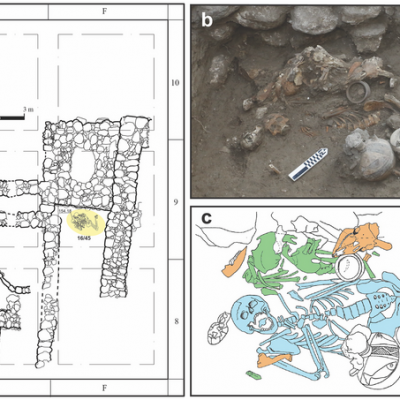Both brothers suffered chronic illness, and one underwent rare trephination around 1500 BC
PLOS
Source - https://www.eurekalert.org/news-releases/979812
 Bioarchaeological context of this study. A: The Area H (H-15) domestic structure, with Tomb 45 highlighted in yellow. B: In-situ photograph of early exposure of burial context. C: Composite drawing featuring all layers. Individual 1 is blue, Individual 2 is green, faunal remains are orange. - Kalisher et al., 2023, PLOS ONE, CC-BY 4.0 (https://creativecommons.org/licenses/by/4.0/)
Bioarchaeological context of this study. A: The Area H (H-15) domestic structure, with Tomb 45 highlighted in yellow. B: In-situ photograph of early exposure of burial context. C: Composite drawing featuring all layers. Individual 1 is blue, Individual 2 is green, faunal remains are orange. - Kalisher et al., 2023, PLOS ONE, CC-BY 4.0 (https://creativecommons.org/licenses/by/4.0/)
Two high status brothers buried in a Bronze Age tomb in Israel were severely ill but apparently had access to rare treatments including trephination, according to a study published February 22, 2023 in the open-access journal PLOS ONE by Rachel Kalisher of Brown University, Rhode Island, and colleagues.
In this study, authors examined the remains of two individuals buried in a tomb beneath an elite residence in the archaeological site of Tel Megiddo in Israel. The tomb dates to the Late Bronze Age (around 1550-1450 BC), and DNA testing suggests the buried individuals are brothers. Both skeletons show evidence of disease, providing an opportunity to study how illness was treated during this time period.
Extensive lesions on the bones of both individuals are evidence of chronic, debilitating disease, possibly a condition to which the brothers shared susceptibility. The advanced state of the lesions indicates that, despite the severity of the condition, these individuals survived many years, possibly due to the privileges of wealth and status.
Additionally, one of the individuals has a ~30mm square hole in the frontal bone of the skull where a piece of bone was surgically removed, a procedure known as trephination which has been used to treat various medical disorders by relieving pressure buildup in the skull. This was likely intended to treat the patient’s ailment, but the lack of bone healing suggests the individual died during or shortly after surgery.
It is notable that the brothers’ tomb was adorned with high quality food and fine ceramics similar to other nearby high-status tombs. This suggests these individuals were not “othered” nor excluded from burial traditions due to their poor health. This serves as an important case study for continuing investigation into the intersections of status, illness, and treatment in societies through time.
The authors add: “Among the study’s multiple findings, we wish to highlight the special type of cranial trephination, the earliest of its kind in the region. This uncommon procedure was done on an elite individual with both developmental anomalies and infectious disease, which leads us to posit that this operation may have been an intervention to deteriorating health.”
Kalisher R, Cradic MS, Adams MJ, Martin MAS, Finkelstein I (2023) Cranial trephination and infectious disease in the Eastern Mediterranean: The evidence from two elite brothers from Late Bronze Megiddo, Israel. PLoS ONE 18(2): e0281020. https://doi.org/10.1371/journal.pone.0281020